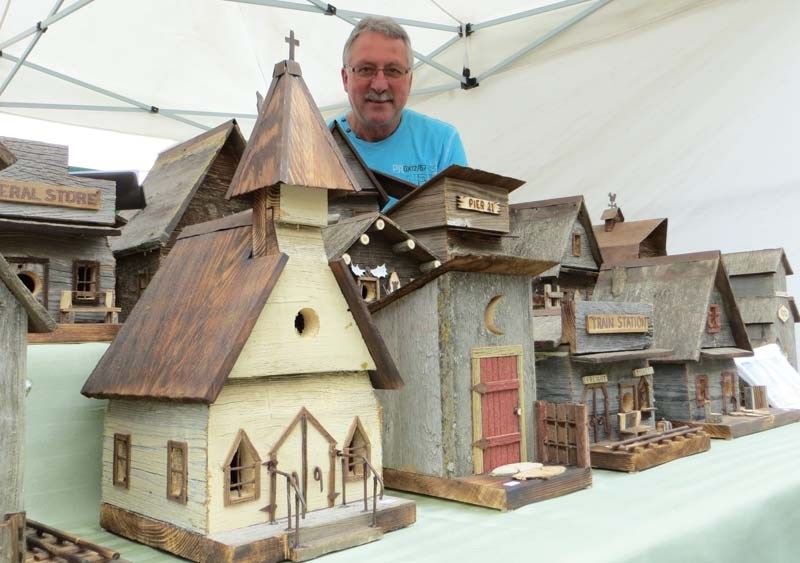St. Albert Farmers’ Market is chock-full of food, art, baubles and trinkets of all sorts. Now shoppers can buy real estate too – bird real estate that is.
In our second summer segment of Market Place, I spotted a crowd migrating around Larry and Lynne Treichel’s booth and stopped to check out the action.
Everyone, children in particular, were hovering over a display of rustic birdhouses. The houses are individual, one-of-a-kind, yet when exhibited as a group they form an old-fashioned, country village.
Standing next to each other are a jail, hunter’s cabin, general store, train station, library and humble outhouse. The ultimate in luxury bird living are a couple of two-storey condos – one a church and the other a barn.
What gives the birdhouses an artisanal flair is the construction materials. Each ingeniously-built residence is assembled from weathered or reclaimed wood, old shingles, rusted tin and barbed wire. The only new off-the-shelf materials are latches and GOOP, a permanent adhesive.
“They’re so detailed. They’re not just a square with a hole cut in front. It’s something that is fun to look at and birds can live in them,” says St. Albert resident Nicole Cook.
Taking advantage of Saturday’s sunny weather, Cook was giving a friend from Regina a tour of the market.
Each birdhouse is meticulously designed and built down to the doorknobs and window frames. But what catapults Treichel’s designs into folk art are the houses’ individual personalities.
For instance, the general store has a pickle barrel on the side and a bench under the window. The foot-high Alberta Wheat Pool birdhouse is circled by a picket fence and sequestered near railroad tracks.
A little boy standing next to the booth points to a school. Standing beside the modest abode is a gnarled tree with a round tire swing hanging from it. The tire swing is made from a hollowed out wood chip.
Displaying a sense of humour, Treichel also built a charming birdhouse with stepping-stones leading to an adjacent water well. On the house is a feathery flyer’s real estate sign that reads “House for Wrent Cheep.”
His favourite house, and possibly the most majestic and endearing, is a two-storey barn with a hayloft and double doors on the main level. It is covered with a curvilinear tin roof supporting a weather vane. Beside it is a huge tin silo adapted from stacks discovered in a broken old heater.
“The detail. That’s the fun part,” says Treichel.
The laidback artisan is a retired third-generation dairy farmer from Rolly View, a hamlet in Leduc County. Designing and building birdhouses was more of an accident than a plan.
Back in 2002, a severe drought hit parts of Alberta, making it difficult to grow or buy feed for his 40 head of dairy cows. At the time, the couple was flirting with the idea of retirement and the drought clinched it.
Even in retirement, life was busy … until 2006.
“He woke up one morning and didn’t have anything to do,” recalls his wife Lynne.
There was very little in Treichel’s background to indicate a passionate artist. In school he used to get his highest marks in art and physical education. And after graduating he took an art talent contest that was advertised on TV and scored in the 90s. But he never followed up.
“It was in the States and I had to pay duty for everything that came across. And besides, I had been a dairy farmer since I was five,” he says.
To keep busy, Treichel hatched the idea of building a few birdhouses for the yard. Surprisingly, the seeds of interest were planted in the 1990s. The couple had holidayed for eight years straight at Sandpoint, Idaho. A folk artist from the area created similar decorative birdhouses. The feathery dwellings complemented the couple’s rustic style house and they purchased several.
Treichel set up shop in his 12-foot by 14-foot milk house. He tore apart an old unused shed and stored the material in the barn. The first birdhouse was modeled on his red barn with a freestanding windmill beside it.
“I started making a few for myself and then my sister and friends wanted some,” Treichel laughs, scratching his head.
Today, shoppers make personal connection with the domiciles. Teachers buy the schools. Firefighters have purchased the fire hall and a sheriff just acquired the jail. One Edmonton shopper picked up a freestanding barn.
“My father was a farmer and we’re buying this for his condo,” she said by way of explanation.
Last year, Treichel built about 220 bird lofts. Although the construction is down to a fine art, he notes that with all the detail, a house can take up to eight hours to finish.
“The biggest satisfaction I get is that I can’t believe this many people are interested in the stuff. It blows me away. Even if they don’t buy it, the compliments are nice.”
He ends the afternoon with a rural chuckle.
“The money isn’t as good as dairy farming, but the smell is a lot better.”




